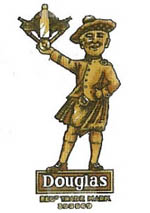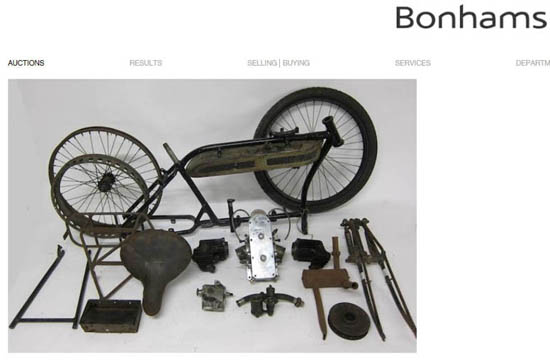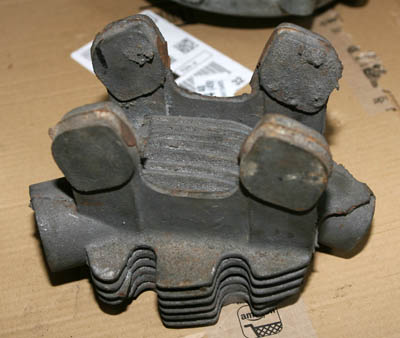
Bonham's at Stafford Show April 2016
and . . .
RacingVincent Goes All Edwardian - 1920 Douglas 2 & 3/4 HP
How a recent trip to Stafford Show resulted in an unexpected purchase
Although I might not have given much indication in previous articles - in recent years I have developed a yearning to own a belt drive 'flat tanker' from the Edwardian era (i.e. 1905 - early 1920's era).
Read on to find out how, almost entirely by accident, I recently happened to fulfill this ambition - at least, if not a complete bike - then the main parts to build one!
(as always - click on any photo to see an enlarged version)
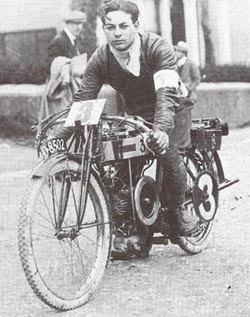
Works rider and future Douglas development engineer Les Bailey on a Douglas 2 3/4 HP 'Works' racing model in the 1912 French GP
As always, my ambition for this latest project bike would be to build something representative of this racing/sports variant
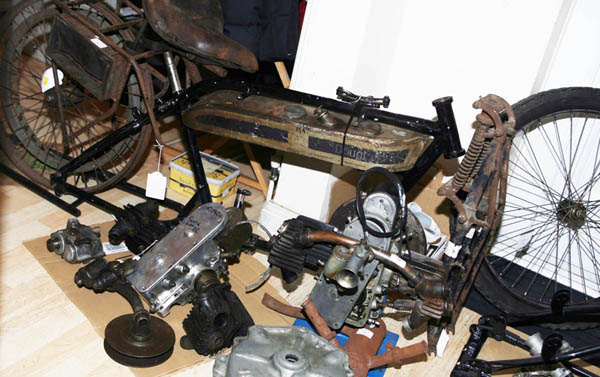
1920 Douglas 2 3/4 HP Parts kit - Shown here on the floor of my dining room on the night I bought it back from auction - imagine how overjoyed my wife was when she saw it - another pile of junk cluttering the house!
If you look carefully, you will notice there are actually 2 engines - and when you click on the picture the bigger version shows a few of the other bits that were acquired on the same day
Background and Trip To Stafford/Bonhams
The Stafford Classic Bike show in April is one of the biggest classic motorcycle events of the year, and has been running for well over a decade now. I would admit, I am not one of its biggest advocates - I think the last time I visited was about 9 or 10 years ago, finding parking difficult and the event a bit crowded for my liking. That said it is a very popular meeting, and one that Bonham’s (my favourite auction house) has used as a platform for its most prestigious annual UK motorcycle auction in recent years.
So back in April, while still pre-occupied fettling my late father's Vincent Comet after its recent full restoration, it was only by co-incidence as I happened to be telling one of my motorcycling mates about it - and that I had also recently purchased a gearbox outrigger plate for my Vincent Grey Flash build (another article still to come!), when he mentioned he had seen a Vincent RFM coming up for grabs in the forthcoming Bonham’s Stafford auction.
I had been telling him I just needed a Vinnie RFM (Rear Frame Member – or rear swinging arm to you and me) to complete the hunt for the major parts for the Grey Flash. I have actually been hunting for the RFM as a back burner quest, ever since I was a teenager and first talked about the possibility of using my fathers Comet spares to build a Grey Flash as my first racer - clearly that never happened!
Over the years a couple of RFM's had almost come into my grasp, but never quite happened - normally because at the time i had other things going on and RFM's have never been cheap!
So, having been told by my mate that he thought he had seen a load of Vinnie spares and at least one RFM coming up for sale at Stafford, even with every thing else going on, I thought this was too good an opportunity and I ought to get my arse in gear!
The original auction listing for the Douglas I was most interested in - Yes, a lot was missing, but most the major components were there and in my opinion - of the seven similar Douglas 'project kits' that were being offered at the auction, this looked the best of the bunch.
I particularly liked the look of the frame and the excellent and very original petrol tank
Brough's at Bonham's
The funny thing is, I had already received a catalog for the auction a couple of weeks before, as I do for all of their motoring auctions, but had only given it the briefest of skim reads. I had seen a number of interesting Brough Superiors coming up for sale in rough unrestored condition – including a very rare twin rear wheel, Austin 7 powered Brough, only a handful of which are still known to exist, all coming from the collection of the late Frank Vague. I gather this gentleman had acquired a collection of Brough’s in the early 1960’s and then had moved to a very remote farm (in Wales or Scotland?).
Unfortunately, It would seem that many of the buildings that Mr Vague stored these bikes in must have been short of maintenance, because clearly they have suffered very badly with the elements and most looked in 'poor to piss-poor' condition – see photos below. But in the rarified atmosphere of the Brough world –rarity overrides condition and these bikes which sold on the Sunday (I only went on the Saturday) still fetched some very high amounts, just proving that unrestored Barn Finds will always attract strong bidding, irrespectvie of condition.
The twin wheeled Austin/Brough eventually fetced an amazing £331k with premium, despite being a long way off from a complete or restored bike, and no doubt will need a lot more money and effort to get it back on the road - but I am sure the person that bought it knows that - hey ho!
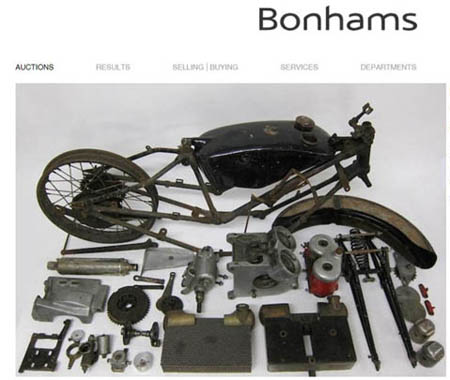
This lovely Scott Squrrel 'Parts Kit' was one of many that took my eye and I spent a long time poring over it on the Saturday morning in the Bonhams tent - it being a tough call between this and the Douglas flat tanker I eventually purchased. This was Lot 3 and therefore came up very early in the bidding. It sold for a very reasonable £1187 and I came very close to bidding myself - but the lure of all the Douglas flat tankers helped keep my hand down!, and eventually I am very glad I did. If the new owner ot this bike is reading though - please emal me and tell me how you got on with it. I was particularly interested in the crankcases being stamped 'TT3', that kind of number always raises my curiosity!
So Many Interesting 'Project Kits' To Entice!
When I started to read the Bonhams catalog in more detail I could see there were lots of other really interesting 'Parts Lots' and projects bikes also in the Saturday auction – making it a potentially entertaining place to spend a day – even if I was only going to be bidding on a few of the smaller items.
But as I started to read through the detail of some of these parts kits, I could not help but find myself salivating! Many of them were from the earliest days of motorcycling - from the 1900's through to the early 1930's. It is rare to nowdays find even one restoration project from those early era's at an auction- but here were approximately 40 - 50 very early basket cases or 'kits' from that era - being mainly of Scott, AJS or Douglas marques. If I did not know better I would say that an old time collector must have passed away and much of the first 70 lots may have all come from the same collector - or maybe two or three at most.
If you would like to have a look at the interesting bikes and project bikes that were for sale on the day, then here is the link – mine was Lot 13: https://www.bonhams.com/auctions/23600/
So, as it happens I have always had a real soft spot for both the Scott and Douglas marque. In the case of Scott's - it takes me back to days spent with Titch Allen in the 1980's-90's where I spent many a pleasent Saturday afternoon tinkering on bikes with Titch down his little lane lined with old buildings and outhouses full of old bikes. He had at least two Scott's - including one with a sidecar very similar to the model in the photo on the left. I grew to like their quirkiness of construction and the yowling 2 stroke noise that only Scott's seem to make - particularly as I came very used to it when we raced his grasstrack Scott outfit in the late 1980's.
And likewise - although I may never have given much indication in previous articles, I've also had a soft spot for Douglas flat tankers for as many years as I can remember. This goes back to days of sprinting against some really outrageously fast OHV Douggies in the 1980's and the combination of blue/silver flat tank, quirky boxer engine and external flywheel all added appeal to make them my joint favourite 'flat tanker' marque (the other being Norton OHV flat tankers of course - which would mean me selling an OHC bike now to afford!).
So in the few days leading up to the auction I found myself warming to the idea of attending the Saturday auction, in main to try and grab one of the Vincent RFM's, but as I found myself emptying all my little piggy banks and trying not to dip too much into the CNC fund . . . I realised I had already put myself in the mindset that if a Soctt or Douglas 'kit' came up at the right price - then I may just be tempted to a point where I would not be able to stop myself!
Brough's at Bonham's - or alternatively: A slight case of Rustworm
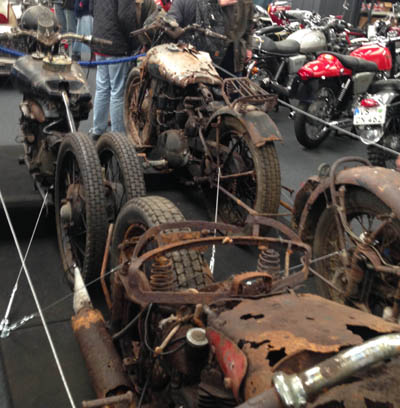
This was the Frank Vague Brough Superior collection that created a huge amond ouf interest - and ultimately so some very high bidding. Austin engined twin rear wheeled Brrough Superior (one of only 10 made) is upper left and finally fetched £331,900 . .. eeek!
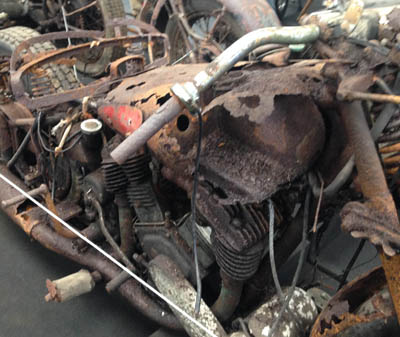
Hard to believe but this 1938 11-50HP model - with what looks to be almost terminal tinworm still sold for a stupendous £41,400.
I know everyone loves a barn find .. . but I think there comes a state of condition where you have to question if the effort of restoration means it would just be easier to go out and buy a better condition bike!
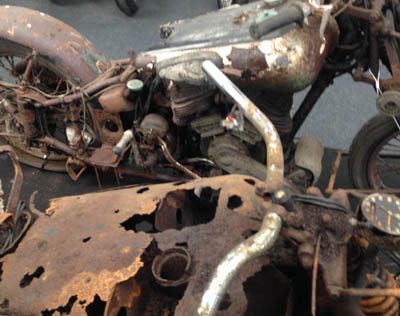
Dont sneeze too close to the this petrol tank - it will crumble away. In the background is a 1938 SS80 'Special' procject bike, which seemed one of the more affordable, it fetched £25,300
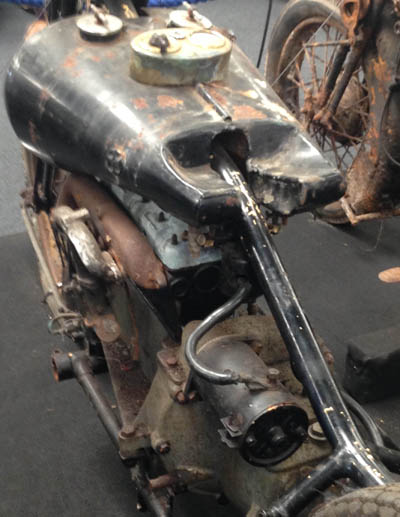
The Austin 7 bike was better condition than some of the others and definitely had some interesting features - I gather it was originally built for sidecar work
Other bikes at Bonham's
Sorry on photo quality - only had shitty Iphone with me on the day - but as alway, click on any photo to see a larger version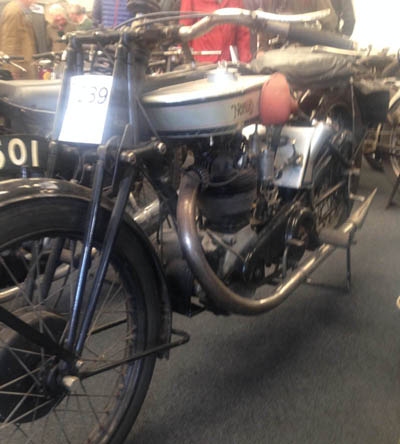
Very nice 1929 Model 18 Norton Flat Tanker was considered one of the most desirable bikes in the sale and this was reflected by the price it fetched - £36,800.
This machine was owned by the well known Norton Brooklands exponent - Pat Driscoll, and it was certainly a lovely and original looking example - no doubt the reason it fetched such a good price
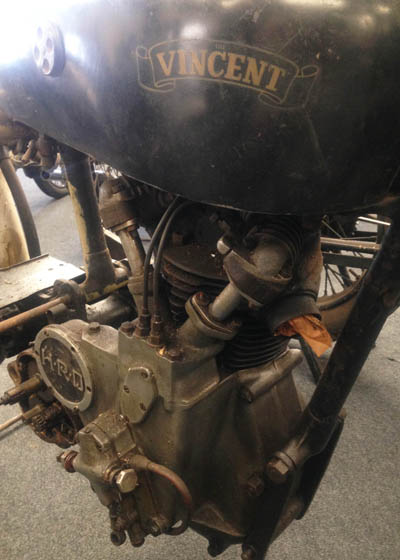
Nice semi-complete pre-war HRD Comet Series A was 1937 and sold for £19.550. Although maching numbers it had a lot of parts missing and was fitted with Girdraulic rather than girders
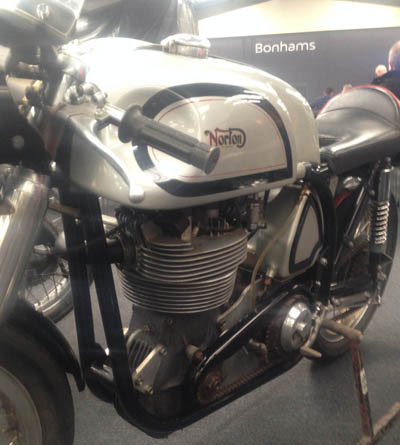
Another nice Norton - 1956 Featherbed DOHC Manx 40M 350 sold for £32,200. A very similar looking 1952 Manx 'Special' 350 only made £10.350 showing the wide gap of prices that can be paid for these bikes
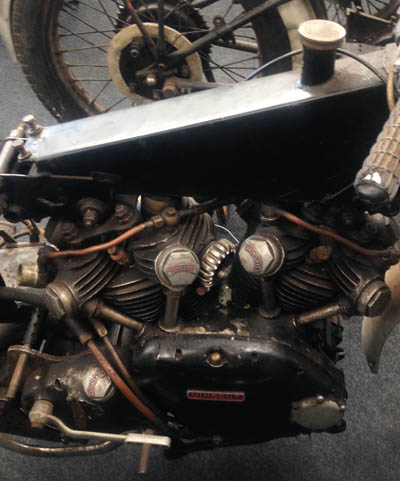
Lovely 'Barn Find' Vincent Black Shadow was one of many Vincent's for sale - as well a huge collection of parts (the main reason initially for me being there!) - I suspect a serious long term collector had passed away and much of the bikes and parts here belonged to his collection. This bike was 1954, last used in 1971 and sold for £44,275
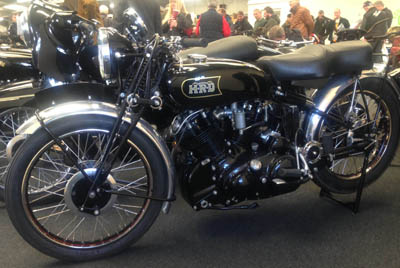
This very nice 1947 Series B Rapide (to Black Shadow specification ) with Brampton forks went for what seemed a very reasonable £34,500 - in my opinion a much better buy than some of the rough Brough's of similar value
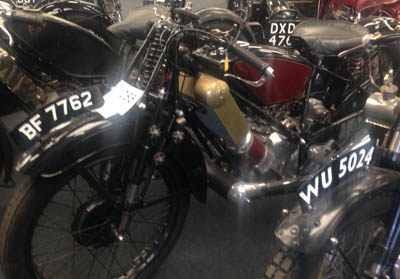
There were numerous Scott's at the auction - including some very interesting 'project kits' on the Saturday (I was very sorely tempted - and came close to buying one of them over the Douglas - glad I went for the Douggie though). This very nice 1929 Flying Squirrel fetched £6,325 while the 1928 model in the background only fetched £3,220 - showing models of this interesting marque can still be purchased at very reasonable amounts
And So To Saturday Auction Itself
I got to Stafford early on the Saturday morning and found the car park already filling up fast, this just after 8.00am. I had bought my VW van, and having done this kind of meeting before – put a wheelbarrow in the back, in case I bought anything large and had a long walk!
What was not expected and very annoying was that to get in before 9.00am they made me pay the full weekend price . . . for the sake of about half an hour . . . robbing so and so’s. I even showed them my auction baton to show them I was only there for the auction – but to no avail, if I didn’t want to spend the next 45 minutes waiting outside I had to pay the full weekend price - that is Stafford all over for you!
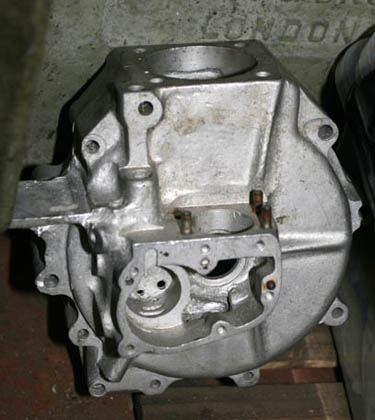
Norton Inter 500 crankcases were found on a stall outside from auction. Not perfect, but a bit of bartering and the price was right. Always nice to have a spare set in case I blow '38 racer's crankcases again
Anyway, getting in early before the crowd gave me the chance to go round the outside autojumble, say hello to a few old mates – and find myself in the normal position of snapping up a couple of bargains I could not afford to leave – which included a reasonable set of late 1930’s Norton Inter crankcases and a Vincent left pot racing inlet manifold and Amal RN carburettor (either Lightning front cylinder – or of course Vincent Grey Flash!). Well less money for the auction, but couldn’t let either of those go could I!
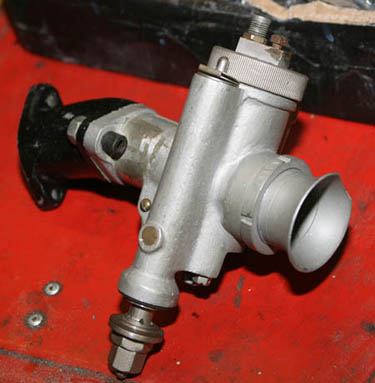
Another nice find at the Stafford autojumble was this long neck RN Amal witha Grey Flash Vincent inlet tract, offered by an autojumbler from Holland.
Long neck RN's are rarer than short necks and were also fitted to Manx's. Looks like previoius owner had broken through inlet tract when making it fit inlet stub, but liquid metal repair seems to have fixed it ok - again, after bartering the price was right!
With the auction itself, Bonham’s had two large buildings/rooms, with the bikes to be sold on the Sunday in the bigger room and the parts and project bikes in the second area, with roped off tables and Bonham’s security guards in attendance.
I spent about 1 to 2 hours in the morning carefully examining all the Vincent lots, along with a number of likeminded enthusiasts and I am sure a few dealers. Of the three swinging arms the first two were in excellent unmolested condition, the second one being from a Comet and that was the one I was most interested in. The third one looked like it had either been repaired or altered, so I decided not to bid on that.
What was really useful was to look at the different project bikes – the Scott I had previously found interesting looked just a s promising in the flesh as did a few of the other kits.
However, it was the Douglas basket cases that really appealed. Unfortunately it was clear that although the Bonham’s people had done their best to arrange the bikes into complete ‘kits’, some of the parts had been mixed up. I think like most of those who were looking to bid on them, it was the ‘teens’ bikes (pre 1920) that appealed most, but on careful examination – I could not find one of them as good, or as complete as the 1920 bike. In fact a couple of the early ones were very rough – one in particular I could see had forks that had corroded through, so I had decided before the auction which one I wanted to bid on.
Incidentally – when the auction actually started I noticed a large percentage of the bidding on these older bikes was either from the phone or internet. I did think to myself – when you are bidding on something like one of these restoration cases, they really should have come and examined – I spotted loads of faults it was not possible to see from the (excellent) Bonham’s photos.
When the bidding started the Scott’s came up first. I was really in two minds if to bid on the Scott (Lot 3), and frankly I could not believe there was not more interest in them.
At this point it is worth stating that unfortunately Bonhams have a much higher levy against parts and memorabilia than they do against motorcycles themselves with regard to commission. For the Saturday auction the commission is 25% rather than 15%, so with final VAT added the final premium to pay is approximately 30% up on the hammer price – which talking beforehand, seemed to have put some off attending.
I think the upshot of this was – although the initial amounts seemed low, those bidding were probably trying to work out in their heads how much they were actually paying!
All that said, the Scott still seemed very reasonable, in fact low, and I came really close to buying – I think I did put one of the bids in, but eventually decided to duck out and save what funds I had for the Vincent RFM . . . and possibly a Douglas!
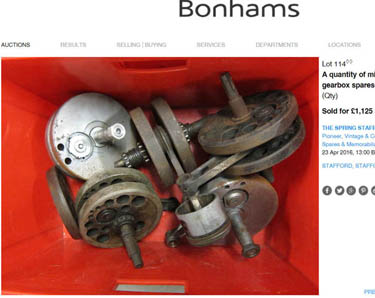
Now here was an interesting Lot . . . click on photo above to look at an enlarged version - then see if you can figure out what these are? , as a clue - both Vinnie and Norton SOHC cranks are present!
I did not bid as did not want the extra weight in my wheelbarrow - but they were cheap!
The Douglas’s came up shortly after – and again, for motorcycles almost a 100 years old – even if only ‘part’s kits’, the bidding did not seem excessive. I did put a couple of bids on the first two Douglas lots, both being pre 1920, but realised the condition of both was not brilliant, so decided to duck out – knowing Lot 13 was coming up.
When Lot 13 did come up, I had already made my mind up for sure that I wanted a Douglas – so this was going to be it! I had noticed most bidding was coming from the internet/phones and therefore confident bidding from the room itself seemed the way to go – so I quickly railroaded my bids in, responding instantly to any phone bids with a counterbid of my own! The final hammer price in my opinion was still lower than I expected, and with premium the final price I paid was £2125, which I think was very reasonable for such a wonderful time capsule.
I carried on bidding on a number of other items, working on the theory – just duck out when it no longer seemed a bargain, and it was probably a good job I did not have more available money in my back pocket, because there were some real bargains to be had – for instance, look at Lot 56, as set of early Webb girder forks of the type fitted to the earliest Cammy Norton’s – even with premium the final price was only £875, if I had been building an early Inter I would have been prepared to pay £2k if I really needed them.
It was a long afternoon and added to that Bonham’s lost the Internet connection a couple of times – which meant delays of approximately 15-20 mins while it was restored – obviously they did not want to lose the opportunity of the internet bidding and I don’t blame them for that.
Vincent Bits Not Such a Bargain!
But although the prices seemed very reasonable in the early part of the auction – that all changed when the large Vinnie lumps eventually came up for grabs!
First up was the Vincent Rapide RFM. This looked a nice item and I was tempted to bid. However, logic told me that the Comet RFM that was to follow would be slightly cheaper – and actually it was a Comet RFM that was more appropriate for me for building a Grey Flash.
I had previously worked out in my head the amount I wanted to pay and subtracted buyer’s premium etc. Ideally I did not want to have to pay more than £1800, and I bet there are a few of the older Vincent owners reading this who would be really surprised at that much, but I knew if push came to shove I might go a fraction more.
Anyway, I watched the Rapide RFM price rise rapidly and decided to wait for the Comet, the Rapide RFM finally sold for £2,125 with premium.
Then, for me anyway – the main event the Comet RFM. This was also a nice one in totally original unmolested condition. However, I hoped it would sell for less than the last one – I was quickly proved wrong. I stayed out for the first few bids, but then came in when it looked to be reaching its end. I felt confident at this point, but at least one phone/internet bidder was not going to let go and eventually I found myself going at least two bids over my self-imposed maximum before I came to the conclusion it was too much and there would always be another – after all I had already been searching for 30 years!
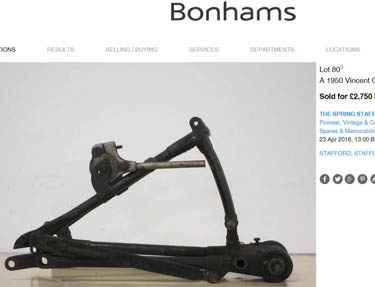
This was my main reason for going to Stafford in the first place - Vincent 1950 Series C Comet RFM. It eventually sold for £2750 - but not to me!
As you can see from the photograph, the Comet RFM eventually sold for £2,750 with premium, probably a new record for a Comet RFM on its own!!
There were a few mutterings and soft intakes of breath in the auction room after this Lot (and a few people sat close to me gave me sympathetic nods) but it seemed to set the scene for what followed – all other Vincent lot’s made similar big money, just showing that this marque is still close behind the Brough Superior in top auction prices. For me though, I shrugged my shoulders and muttered a few profanities under my breath, but knew it was the right thing to do – I knew another would come my way sometime in the future.
However, what I did not realise was, was just how quickly that next opportunity would come, because about 10 minutes after losing the RFM, with the auction still in full swing, I got a tap on the shoulder. Turning round, an old boy I had never met before whispered in my ear – would you really have paid that much for an RFM? So I whispered back – ‘well obviously, because I did!’, so from that we agreed to meet outside a few minutes later. It turned out the old gent who introduced himself to me was a collector himself and did not live that far away. Amongst his parts he had a spare RFM himself and asked if I wanted to come and look at it after the auction? In an amazing stroke of luck, that is exactly how it turned out. The auction went on for another couple of hours – even I was knackered at the end of it, and about 5pm the kind gent and his brother tailed me as I wheeled off my wheelbarrow full of Douglas and Norton parts to the van, and we then travelled about 5 miles to an industrial unit where low and behold – amongst other dusty items was an extremely clean and nice Vincent Series C RFM. We agreed a reasonable price (much less than the price at the Bonhams auction I am pleased to say and – hey presto, I had managed to come away with an RFM as well as the Douglas after all – mission accomplished!
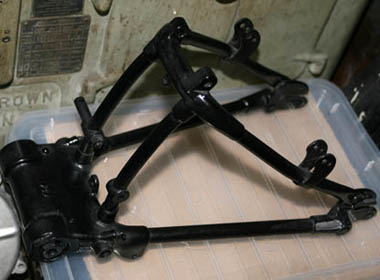
And here is the RFM that I was lucky enough to purchase - also a Series C Comet RFM, just as good condition as the Bohnaams one - oh, and substantially cheaper.Eventually this one will be drilled and lightened around the swinging arm pivot area and painted grey
In respect to the kind gentleman’s privacy I won’t give any more details about who he was, but it turns out we got on rather well – both him and his brother, and at the end of a long day, he asked me if I fancied a short drive to his other location, where he showed me some of his collection – and what a collection it was! . . . Save to say there was some pretty amazing bikes – Vincent and Norton’s included, and it was a great end to a nice day.
But before I finish on the auction, I probably should mention what happened towards the end of the auction – and the reason I could not meet up with my new friend until 5pm. Having made the effort to get there, and being sat there for a good length of time waiting for the auction to start, had given me an opportunity to go through the Saturday catalog in some detail. From doing this I had noticed a rather poor photograph of yet another Douglas item – a spare Douglas 2 3/4HP complete engine/carb/mag mounted on what looked like an engine stand, right at the end of the auction.
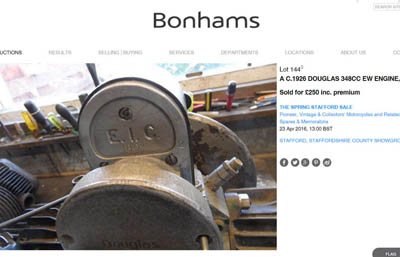
Above is the listing for what turned out to be a complete Douglas 2 3/4 HP engine, although from the photo only the magneto was vsible. As hoped, that and being close to the end of the auction may have kept interested bidders to the minimum as I was only bidded. Below is same engine on shelf at home- will be useful for some parts missing from project bike
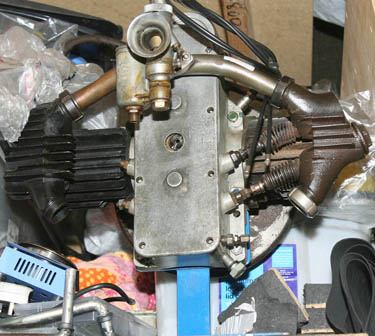
My logic was – as all the other Douglas parts had sold right at the beginning of the auction, then by the end of the auction all the Douglas enthusiasts may have gone, even the most hardy of attendees were getting weary . . . maybe I would get the engine for a song?! It was listed as a Douglas EW engine, and only had a picture of a magneto on the catalog and in the auction . . . but from looking at it, I thought it looked very much like a late Douglas 2 3/4HP engine. . . just like the basket case I had just bought. By the time this engine came up – about 4.30 pm, everybody left was looking pretty tired and disinterested!
The previous two lots had received very little interest and when the picture for this lot came up (see photograph – just a magneto showing), all it seemed to receive from those in left in the room was a long sigh! After about two attempts on the part of the auctioneer trying to get a response to the starting price he had offered, and when it was looking like he was just about to knock it down as a ‘no bid’ . .. I quickly put a finger up, just long enough for him to see it. As I hoped, he seemed happy just to get any offer and did not want to dwell, therefore gave a few more seconds and a half-hearted attempt to eyeball across the room – before knocking it down for me at the starting bid! (£250 with premium and vat).
For me this was a real result – because it turned out, as expected, this was a seemingly complete and good condition late Douglas 2 3/4HP engine (not EW as stated in the listing) – complete with early EIC magneto, external flywheel (which my ‘kit bike’ was missing),inlet manifold, carburettor and engine stand . . . I would have expected to have spent that amount for a good condition magneto on Ebay
!
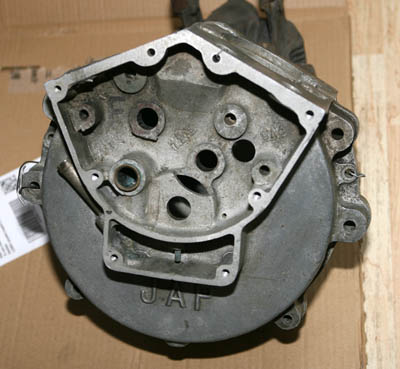
Final (and unplanned!) purchase of the day - JAP LTOR/C crankcases and unmachined left 'DogEared' head - starting point for big Morgan engine!
I couldent bring myself to leave them unsold .
Available for swap or sale at some point in the future
As a Final Footnote;
I have been to a few auctions in my time, including a few of Bonham’s and I would have to say the quality of parts (and bikes on the following day) overall was better than any other auction I had ever attended. If I was a trade autojumbler (as I think a few in the audience were) and had about £30k in working capital – I think it would have been possible to make a real killing, because through the afternoon there were some real bargains and rarities on offer – good luck to all those who made the effort to sort them out and got them . . . I know I bid on lots more than I mentioned here (including a few Norton rarities), but it was only that I was working to a budget (that I had already overspent from) that kept me buying much more.
As a very real example of this – just two bids before the Douglas engine at the end of the afternoon, a set of JAP V twin crankcases and un-machined OHV ‘Dog Ear’ cylinder head came up for grabs. I was just coming back into the bidding area at the time, awaiting my Douggie engine, but could hear that the auctioneer was struggling to raise any interest! When it was clear from the shuffling of feet that no one could be bothered to bid on them – I really couldn’t let them go at that price – so bought them myself!
Admittedly, they just added to my problems of carrying everything back to the van in my wheelbarrow (I was soaked with sweat after my half hour trek, having to stop regularly to stop wheelbarrow overbalancing and pulling my arms from sockets!), but just could not bear to leave them. The crankcases are stamped LTOW and have been welded in areas, I expect in anticipation of building them back one day into a Morgan OHV V Twin engine, hence the head. I believe the LTOW was the big OHC water cooled V-Twin engine. I will probably use them as swap or sale items at some point, email me if you are interested.
Douglas Photo Gallery - Postrcript (early 2017)
As I complete this article it is now early 2017, and as always other things have conspired to drag me away from completing it back at the time – sorry for that.
However, what I can say is that – having got the Douglas back home in Spring 2016 I then embarked on a four month push where any hobby time was spent working on this bike – trying to get it into a ‘rolling chassis restoration’, so I could work out what was missing and what fitted – or dident fit as the case may be!
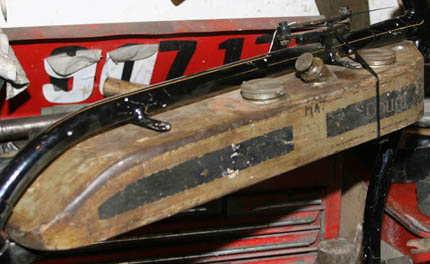
One of the selling points of this project bike for me whas the fantastic and very original petrol tank - seen here on my worksbench the week after the sale. The inention is still that I when I strip everything else down to paint & plate - I will respaint and line the tank in classic silver and navy blue. But as you will see from later photographs, there is definitely a temptation to leave as is!
I learnt an awful lot about this particular Douglas model, and how prodigious it was in it’s day – in one form or another it was offered from approximately 1910 all the way through to the early 1920’s, in numerous model guises. As I was hoping when I bought it – in the early days (particularly pre- World War One) it was raced by Douglas themselves, and therefore there are period photo’s and specifications available of more sporting examples which competed at the time – including the ‘Works’ version of the model which in 1912 won both the Junior Isle of Man TT and the Brooklands Junior GP later that year.
Without trying to get too anal about replicating specification – as my engine and frame both show it as being a later 1920 model, I have decided to try and emulate the ‘look and feel’ of one of these early racing model’s.
But in the following four months of intensive work and investigation that followed the auction - the overriding view was just how amazing and enjoyable it was to be working on a bike that is now almost a 100 years old, and how everything has such a tremendous feeling of age!
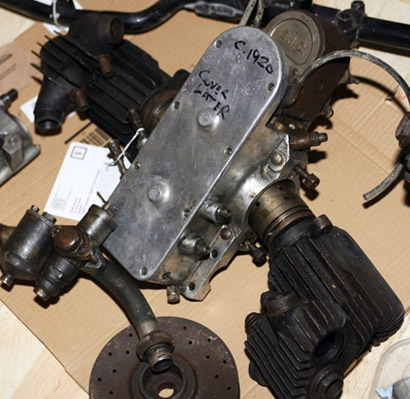
The engine that came with the project bike, as it was from the auction. It is an interesting layout with the crankcase bolting to the frame rail at the lower rear. Notice at this stage cylinders not bolted on. Later, as I got to know all the different features that changed over the long 10+ year run of this model I realised one cylinder was of earlier design than the other - but by a twist of good fortune - so was the spare engine, but oppositely opposed - so two matching pairs after all!
This model was also one of those chosen for use by the British Army in World War One – I believe almost 25,000 were eventually produced for them, although only a handful survived. But what has made the project even more poignant is finding original traces of early type British Khaki paint on some of the peripheral parts that came from the bike – showing that although the frame and engine are of 1920 vintage, some of the other parts ‘assembled’ into the kit were from earlier WW1 examples – just adding to that amazing feeling of age.
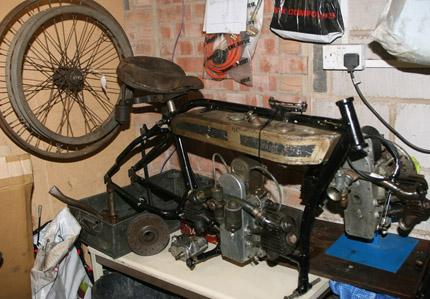
This was first trial build of Douglas engine in frame, and first setting out of a build space in my workshop. Notiec spare ening on stand at back and belt drive rear wheel hung up on wall
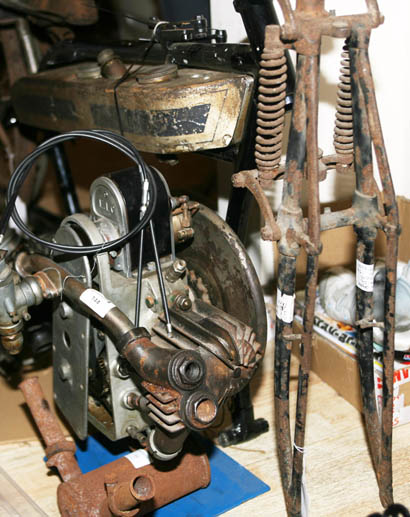
Another photo of parts as they arrived laid out on kitchen floor. Note flywheel at back of spare engine. Also - very rusty but original exhaust system - which I may not use as period racing exhaust different. Forks had light to medium rust but are wonderfully original and complete. I later found out these were the early type which were superceded in approx 1919 - but that for me is a really good point, as I want to build to the circa 1913-14 TT Spec which these are correct type for - more luck than judgement!
I will write another article shortly to cover the first part of that build, back in 2016, with more photographs. That first phase culminated in my being able to take it ‘loosely assembled’ and approx 70% complete (but not restored) to a Brooklands Motorcycle Reunion meeting in July 2016. I am pleased to say it got far more interest than one of my Norton’s sat next to it – it seem’s lots of other likeminded enthusiasts also like the idea of an Edwardian sports bike!
But for now here, here are few photograph’s to show it in more detail:
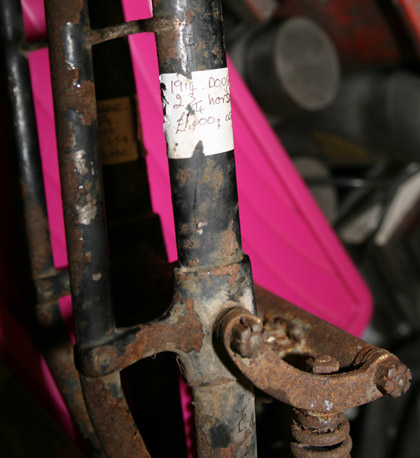
A couple of days after getting bike back home, i started a more careful examination. Poignantly, I found the previous owner (who I suspect had recently passed away - hence all the Douglas parts at the auction) had left some helpful little notes on some parts - including this one on the fork leg confirming the forks were actually of 1914 vintage. Not sure if the £1000 value he put against them was what he paid or the insurance value! I later stripped them and suspect all parts were original, even the wasted fork spindles
- more for a future article
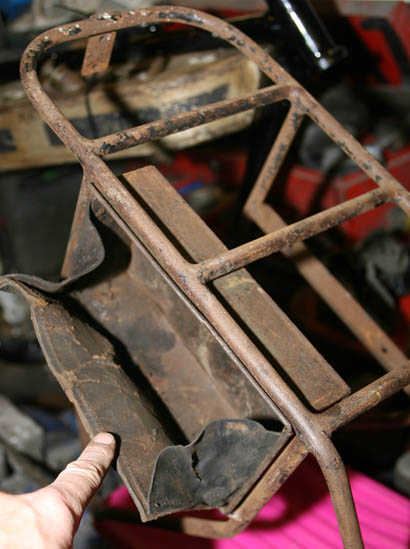
Another lovely time capsule. Original rear carrier has rust but is very solid. It came with one toolbox - which although the tin is quite badly corroderd at the base - still had part of the leather interior and traces of the original khaki green paint - indicating it probably came from a WW1 army bike . . . I shall do all I can to sympathetically restore this item, and try to keep some of that amazing paint.
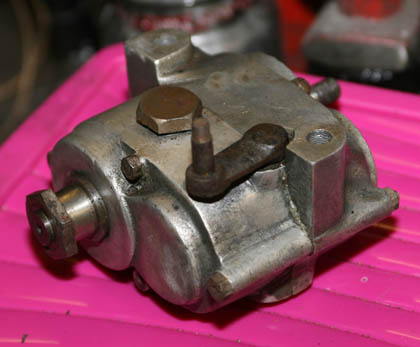
A feature of the Douglas 2 3/4hp model from its earliest days was that although of belt drive transmission, with no clutch fitted - it did have a two speed transmission - in the form of this lovely dinky 2 speed countershaft gearbox. I have subsequently cosmettically restored it and made up new frame mounting bolts and nuts, but still may strip it before final assembly to re-pack with fresh oil and grease. By the way, still looking for a correct Douglas chain drive sprocket to the engine for this unit if you have one?!
Incidentally, later models came with the option of three speed gearbox and clutch. Again, I am pleased I was able to get the earlier unit - as this is correct spec for a 1913-14 TT spec model I believe
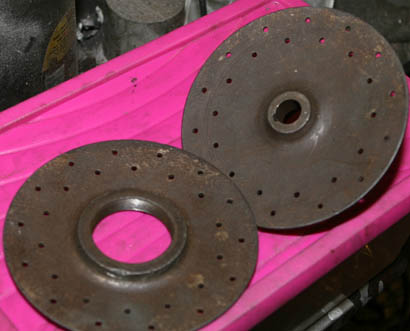
Belt drive sprocket - and again, lovely and original and correct type for the model I want to recreate. Unfortunately quite badly worn where the belt fitted and the taper shaft badly worn and out of round. It operates on a thread with locking ring, which was a clever way of allowing a variable gear to be applied - no doubt to help the rider on steep hills where he could dismount and by loosening the lock ring adjust the width, and hence belt depth in sprocket. I have subsequently refurbished this and machined new lock ring which I will cover in a future article
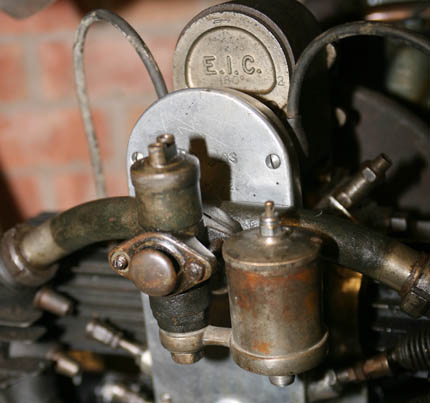
Another time capsule item - this time the original type Amac carburettor and float chamber, on an original twin manifold. I have not stripped it yet, but I believe it is the correct model for this bike (I have seen a few restored bikes with what look like later carbs fitted - including the small Amal fitted to my spare engine). Again - note possible WW1 khaki paint on carb and manifold . . . . a difficult one because I want to restore the carb - but not remove the paint!
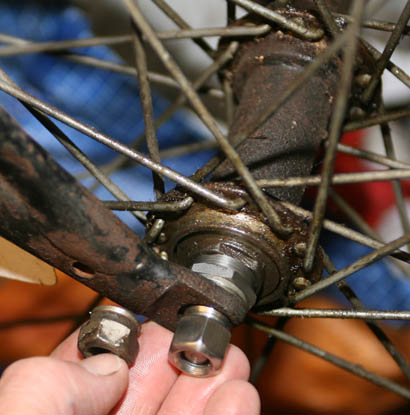
And of course - in the 4 months starting to work on the bike after purchase I started some of the refurbishment and build tasks, in this case starting to machine many of the fastenings in stainless steel (which looks just like original Nickel plate finish) - but ensuring I try and adhere to the original design. In this case the loose wheel nut was an original, but quite dog eared. The one on the wheel spindle is my own machined on lathe.
Front hub has cycle style loose balls and cone bearings. I stripped and reffurbished as best I could . There is some wear on cones - showing it had a lot of use in its earlier life, but for the mileage I will be doing I think they will be fine. Will probably strip and respoke wheel before final assembly
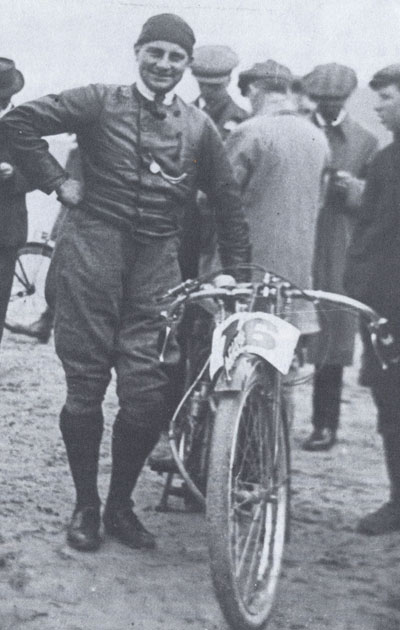
Willie Douglas himself on a similar racing Douglas 2 3/4 hp model, at what I believe was an early sand race pre World War 1 (probably 1912)
I doubt if the engine specification was little different to standard - I would suppose they were mainly standard with just stripped back running gear
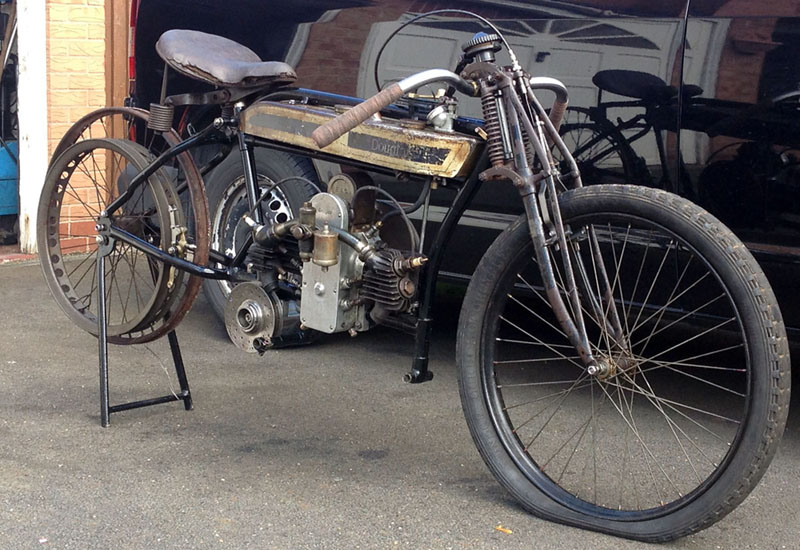
As a last photograph - jumping ahead to July 2016, this is what my Douglas looked like at the time I took it to the Brooklands Reunion - very different to the basket case purchased in April. Still lots of work to do before final stripdown for plating and painting - but a lot of work now done. Do you like handlebars? - made specially for this bike, including machining the mounting block from solid - pattern taken from period Brooklands photos.
I will cover many of the restoration tasks in teh next article, but build went on hold shortly after this photo taken, to allow for setting up of CNC lathe
